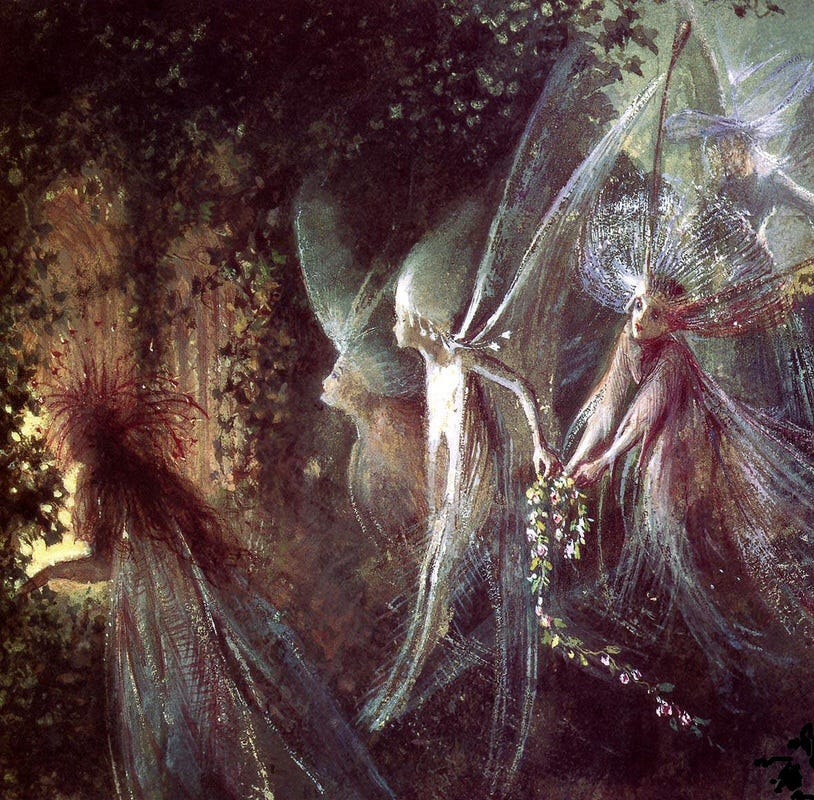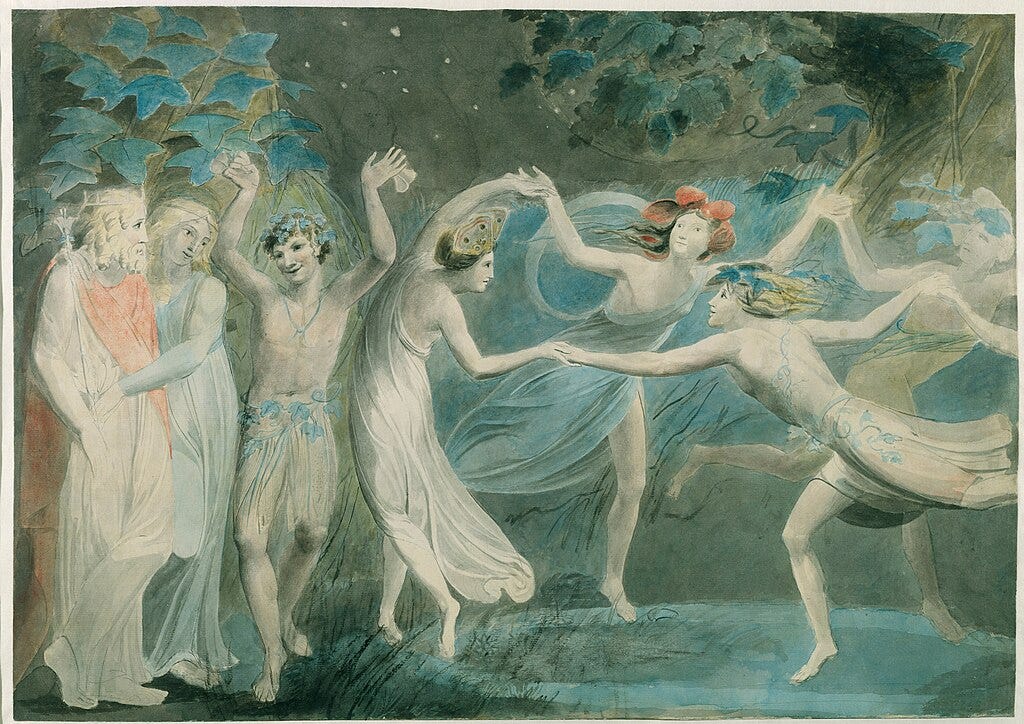Warning From a Tiny Doppelganger – What Can We Learn from an Old Folktale?
Which parts of yourself are you burying?
I found an old folktale recently and it’s so peculiar that I’ve been puzzling over what it means and what it can teach me. Because I think you can approach folklore in two ways — searching for the deeper meaning, or accepting that there is such a thing as fairies, selkies and water monsters (I’m happy with either, to be honest).
The story is from rural Lancashire, where my roaming life recently took me. I was pet-sitting for two dogs in an old farmhouse surrounded by misty fields and meadows. There was just the right amount of drizzle, just the right amount of crisp air, and just the right amount of mellow, tentative sunshine to make it the ideal place to welcome in autumn.
And it was also the ideal setting to explore the folklore of the region, something that I like to do (here’s my post on strange Sussex tales). One story in particular caught my eye: the legend of the Penwortham Fairy Funeral. And that’s because it’s mad-as-a-box-of-boozy-badgers bizarre.
The Penwortham Fairy Funeral
This story first appeared in published form in James Bowker’s Goblin Tales of Lancashire (1878), although it might well be centuries older. It takes place in the town of Penwortham, around Castle Hill, the site of the 14th-century church of St. Mary’s (interestingly, St. Mary’s is near to a lost healing well, a pilgrim route, and an old woodland trail known as Fairy Lane — so, you know, the sort of place where you might expect to find all sorts of peculiarities hiding in the undergrowth).
Here’s the yarn — on a moonlit night, two men are walking home from a farmhouse at the foot of Castle Hill, towards the village of Longton. One is a cow doctor, so perhaps he was tending to cattle at the farm. We aren’t told the profession of the second man, only that his name is Robin (a name associated with death, which is relevant to this tale). As Robin and his friend climb the hill, they pass through the graveyard at St. Mary’s just as the church clock strikes midnight. So far, so gothic.
Leaving the graveyard, they are walking towards a nearby lodge when they hear a second bell, different from the church chimes. Suddenly, the lodge gate swings open and a little man in a red cap and dark attire steps out, chanting as he does so. Following behind him is a procession of other little people in dark clothing, making their way to the graveyard. They are carrying a coffin and singing a requiem.
It so happens that the coffin is open, so Robin — presumably fairly shaken at this point — peeks inside. To his horror, he finds myself staring back at his own face. The pale corpse in the coffin is a miniature version of himself. In shock, Robin reaches out and touches the leader of the procession, the little man in the red cap. At that moment, the entire funeral party vanishes into thin air. Then a storm breaks out across across Castle Hill.
This story has a grim epilogue. Robin (perhaps not surprisingly), loses his mind afterwards, falls off a haystack to his death, and is buried in St. Mary’s graveyard — the site where he saw his dead double.
Fairy funerals and strange doppelgangers
I have to say that out of all the folk tales I’ve ever encountered, this one is particularly off-the-wall. Not the fairy funeral part — mentions of these show up in local lore across Britain, from Cornwall to the Scottish Highlands. And interestingly, a similar story to the Penwortham one also hails from Lancashire. Visionary poet and artist William Blake even claimed to have seen a fairy funeral in Felpham in 1784, which may have inspired him to paint ‘Oberon, Titania and Puck with Fairies Dancing’. In his words:
"I was walking alone in my garden; there was great stillness among the branches and flowers and more than common sweetness in the air. I heard a low and pleasant sound, and knew not whence it came. At last, I saw a procession of creatures of the size and colour of green and grey grasshoppers, bearing a body laid out on a rose-leaf, which they buried with songs, and then disappeared."
However, while fairy funerals are a bit of a thing in British folklore, the element of the eerie double in the coffin seems to belong to this story alone. So I’ve found myself wondering what it all means, symbolically. Why has this tale lingered on for centuries?
Of course, stories of people seeing their doubles (“doppelgangers”) show up worldwide. They are commonly thought to be portents of death and this was certainly the case with poor Robin (plus the robin bird is also seen as a death omen). But what is the meaning of seeing a tiny, deceased fairy double in a coffin — other than the possibility that Robin and his pal munched on a few strange mushrooms on their late-night walk?
The wild and untamed fairy self
Think about what the fairy archetype represents: wildness. Mischief. Magic. Playfulness. Weightlessness. Harmony with nature. All things that our everyday lives can lack. Which is why I think the image of the fairy corpse in the coffin could represent dying or buried parts of ourselves — and might be a stark warning to us all.
Because in a sense, we all have a fairy doppelganger — a wild, untamable self. One who might be more at home sipping honeysuckle nectar than drinking a latte in a coffee shop chain. More at home riding on the back of a bat by moonlight than sitting bored on a National Rail commute. More at home dancing in a bluebell glade than making polite conversation at a networking event. Fairies are wild winged things, butterflies that will never be pinned, visitors who flit in and out of our world from some sweet, heady kingdom that exists east of the Sun and west of the Moon.
Our fairy self is also, by nature, tiny — it needs to be. Most of us couldn’t get through our lives as responsible adults if we allowed it to grow bigger than a thimble. We also can’t hold, control or tame it because, if we did, it would no longer be our fairy self. It would be some sad, frayed creature, wilted as a late autumn leaf. All we can do is allow this wee wild self space to breathe and be. But if we suffocate this vital force then it might sicken and pass away, leaving our lives and souls barren, leaving us unmoored and unhinged.
The little things that we bury
Or there’s another way of looking at this story — maybe it’s about the death of tiny dreams? Those little goals and desires that you cherish but eventually pack away because you think they aren’t important or grownup or productive enough. Those “silly and trivial” wishes. Or those fleeting poems or songs you don’t write down because you’re too busy or think they aren’t worth much.
Perhaps we can survive the death of a few tiny dreams, but the more we bury, the more of ourselves we lose. In other words, letting one tiny dream die might leave a small dent in your heart, but letting a dozen of them decease will create an aching cavern inside of you.
If you feel empty at times, is it because you let one big dream die? Or lots of little ones? If it’s the latter, then maybe all those little dreams collectively point the way to the one true road you need to take.
Perhaps Robin really did see something inexplicable on that moonlit night near St. Mary’s Graveyard — you never know. But whatever the truth, the image of the fairy doppelganger in a coffin is, like I said, a warning to us all. Robin’s fate is cautionary — it suggests that if we abandon our enchanted nature, or too many tiny dreams or creative ideas, then our true self might one day breathe its last. After all, we’re told that Robin’s friend was a cow-doctor but we aren’t given Robin’s profession. Was he simply drifting through life, directionless and lost? Was he haunted by unrealised potential?
If I were to guess what Robin’s madness was about then, given the symbolism of his name, I think he was a man on the brink of soul death. When he was confronted with the reality of that, he lost his mind. I think he saw a warning that he couldn’t heed.
We need our fairy doppelgangers. They entice us away from the cage of the civilised world into the untamed realms of nature, music, dancing — and parties that last a day and a night. They represent small dreams and artistic impulses that should be cherished, not placed in a coffin. But without our impish doubles, we are lost forever in a grey industrial maze, an endless labyrinth of screens.
Which is why you must walk deep into the forest, find a winding, overgrown path, and allow yourself to get lost. If you are lucky, you might spot a tiny being fluttering by your side, a flicker of light that is the buried spark within you.
The Beckoning is supported by you. If you’d consider sharing this post, buying me a coffee or upgrading to a paid subscription, that would help a lot.
This newsletter is written by a wandering Scottish writer who is currently travelling across the UK as a full-time house-sitter. I hope that you’ll join me on the journey. If you liked this post then you might like Three Strange and Mysterious Stories from Sussex, In Search of the Lost Domain and E is for Enchantment.








Beautifully written, Deborah!
'The death of tiny dreams' love this 🙌 such a beautiful post! Also so cool to see that you do house/pet-sitting full time! I do too! Well, not quite as far roaming as you - we're cat-sitting in a country house hotel in Cornwall for 7 months currently as my partner's job is here for now but we've done a few long term pet-sits in the UK and whilst travelling. It's such a lovely way to travel, get to know an area really well and offer something for an exchange & look after some cute pets on the way! Just found you this morning and have been really enjoying reading your beautiful writing and pouring over all your adventures around the UK!